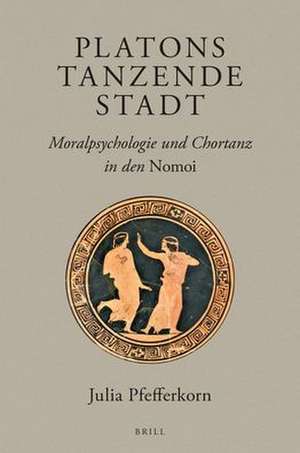Platons tanzende Stadt: Moralpsychologie und Chortanz in den <i>Nomoi</i>: Brill's Plato Studies Series, cartea 11
Autor Julia Pfefferkornde Limba Germană Hardback – 11 ian 2023
Ausgezeichnet mit dem Conrado Eggers Lan Prize der International Plato Society 2022.
Why is choral dance (χορεία) so prominent in Plato’s Laws? In answer to this question, this book offers an in-depth analysis of the dialogue’s moral psychology, arguing that dance is not only an educational instrument but also, in terms of the physical expression of ordered pleasure, a symbolic image of the principal goal of moral education: moderation (σωφροσύνη). Thus, choral dance becomes a powerful construct to illustrate Plato’s main philosophical concerns. Other key features of the book include an innovative account of the dialogue’s complex composition, new interpretations of the puppet image and the tragedy claim, and the first chapter-length investigation of the moral funtion of shame.
Winner of the Conrado Eggers Lan Prize of the International Plato Society 2022.
Din seria Brill's Plato Studies Series
- 18%
 Preț: 1000.94 lei
Preț: 1000.94 lei - 18%
 Preț: 938.51 lei
Preț: 938.51 lei - 18%
 Preț: 804.09 lei
Preț: 804.09 lei - 18%
 Preț: 952.73 lei
Preț: 952.73 lei - 18%
 Preț: 599.50 lei
Preț: 599.50 lei - 18%
 Preț: 605.47 lei
Preț: 605.47 lei - 18%
 Preț: 704.35 lei
Preț: 704.35 lei - 18%
 Preț: 669.22 lei
Preț: 669.22 lei - 18%
 Preț: 850.68 lei
Preț: 850.68 lei - 18%
 Preț: 772.74 lei
Preț: 772.74 lei - 15%
 Preț: 527.79 lei
Preț: 527.79 lei - 18%
 Preț: 642.26 lei
Preț: 642.26 lei - 18%
 Preț: 1376.69 lei
Preț: 1376.69 lei - 18%
 Preț: 605.33 lei
Preț: 605.33 lei - 18%
 Preț: 536.26 lei
Preț: 536.26 lei
Preț: 525.14 lei
Preț vechi: 617.81 lei
-15% Nou
Puncte Express: 788
Preț estimativ în valută:
100.50€ • 103.82$ • 83.64£
100.50€ • 103.82$ • 83.64£
Carte indisponibilă temporar
Doresc să fiu notificat când acest titlu va fi disponibil:
Se trimite...
Preluare comenzi: 021 569.72.76
Specificații
ISBN-13: 9789004525610
ISBN-10: 9004525610
Dimensiuni: 155 x 235 mm
Greutate: 0 kg
Editura: Brill
Colecția Brill
Seria Brill's Plato Studies Series
ISBN-10: 9004525610
Dimensiuni: 155 x 235 mm
Greutate: 0 kg
Editura: Brill
Colecția Brill
Seria Brill's Plato Studies Series
Notă biografică
Julia Pfefferkorn, Dr. phil. (2020, Tübingen und Salerno), ist gegenwärtig wissenschaftliche Mitarbeiterin in antiker Philosophie an der Universität Trier. Unter ihren jüngsten Veröffentlichungen sind der Tagungsband Platonic Mimesis Revisited (Academia 2021, IPS 40) und der Artikel „The Three Choruses of Plato’s Laws and their Function in the Dialogue“ (Phronesis 66/4, 2021).
Julia Pfefferkorn, PhD (2020, Tübingen and Salerno), is currently assistant professor in ancient philosophy at the University of Trier. Her most recent publications include the conference volume Platonic Mimesis Revisited (Academia 2021, IPS 40) and the article “The Three Choruses of Plato’s Laws and their Function in the Dialogue“ (Phronesis 66/4, 2021).
Julia Pfefferkorn, PhD (2020, Tübingen and Salerno), is currently assistant professor in ancient philosophy at the University of Trier. Her most recent publications include the conference volume Platonic Mimesis Revisited (Academia 2021, IPS 40) and the article “The Three Choruses of Plato’s Laws and their Function in the Dialogue“ (Phronesis 66/4, 2021).
Cuprins
Vorwort
1 Einleitung
1 Eine tanzende Stadt
2 Zum Stand der Forschung
3 Vorhaben
2 Prooimion
1 Grundzüge der Nomoi
2 Die Sprache des Ungefähren: Einige Bemerkungen zum Stil
3 Die Marionette im Rausch
1 Einleitung
2 Die These
3 Krieg und Frieden: Der Kontext in Nomoi 1
4 Die Marionette als Projektionsfläche der umgekehrten Analogie
4 Mäßigung (σωφροσύνη): Eine uneinheitliche Konzeption?
1 Einleitung
2 Mäßigung als bürgerliche Tugend
3 Mäßigung in Nomoi 3–5
4 Appendix. Πᾶσα ἀρετή: Die übrigen Tugenden ἀνδρεία, φρόνησις, δικαιοσύνη
5 Scham (αἰδώς und αἰσχύνη): Eine göttliche Furcht
1 Einleitung
2 Scham als moralische Emotion
3 Die Drei Chöre des zweiten Buchs I: Scham, Mäßigung und Lebenszeit
6 Das Verhältnis von Nomoi 2 und 7: Ein ungelöstes Problem
1 Einleitung
2 Das zweite Buch: Eine ‚Abschweifung‘ im Gespräch?
3 Das siebte Buch: Eine ‚Ergänzung‘ zum zweiten?
4 Die Drei Chöre des zweiten Buchs II: Ein Fest für Dionysos
7 Ebenen der Mimesis: Tanz und Gemeinschaft
1 Einleitung
2 Mimesis und Tanz
3 Die Drei Chöre des zweiten Buches III: Mimesis und Gesellschaft
8 Tanz mit den Göttern: Religion und Kult in den Nomoi
1 Einleitung
2 Elemente der Polis-Religion
3 Die schönste und beste Tragödie
4 Eine schlechte Allseele?
9 Schlusswort
Bibliographie
Ausgaben, Übersetzungen und Kommentare
Hilfsmittel
Kritische Literatur
1 Einleitung
1 Eine tanzende Stadt
2 Zum Stand der Forschung
3 Vorhaben
2 Prooimion
1 Grundzüge der Nomoi
2 Die Sprache des Ungefähren: Einige Bemerkungen zum Stil
Erster Teil: Moralpsychologie
3 Die Marionette im Rausch
1 Einleitung
2 Die These
3 Krieg und Frieden: Der Kontext in Nomoi 1
4 Die Marionette als Projektionsfläche der umgekehrten Analogie
4 Mäßigung (σωφροσύνη): Eine uneinheitliche Konzeption?
1 Einleitung
2 Mäßigung als bürgerliche Tugend
3 Mäßigung in Nomoi 3–5
4 Appendix. Πᾶσα ἀρετή: Die übrigen Tugenden ἀνδρεία, φρόνησις, δικαιοσύνη
5 Scham (αἰδώς und αἰσχύνη): Eine göttliche Furcht
1 Einleitung
2 Scham als moralische Emotion
3 Die Drei Chöre des zweiten Buchs I: Scham, Mäßigung und Lebenszeit
Zweiter Teil: Chortanz (χορεία)
6 Das Verhältnis von Nomoi 2 und 7: Ein ungelöstes Problem
1 Einleitung
2 Das zweite Buch: Eine ‚Abschweifung‘ im Gespräch?
3 Das siebte Buch: Eine ‚Ergänzung‘ zum zweiten?
4 Die Drei Chöre des zweiten Buchs II: Ein Fest für Dionysos
7 Ebenen der Mimesis: Tanz und Gemeinschaft
1 Einleitung
2 Mimesis und Tanz
3 Die Drei Chöre des zweiten Buches III: Mimesis und Gesellschaft
8 Tanz mit den Göttern: Religion und Kult in den Nomoi
1 Einleitung
2 Elemente der Polis-Religion
3 Die schönste und beste Tragödie
4 Eine schlechte Allseele?
9 Schlusswort
Bibliographie
Ausgaben, Übersetzungen und Kommentare
Hilfsmittel
Kritische Literatur
